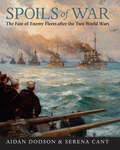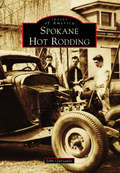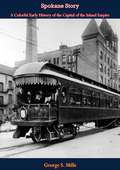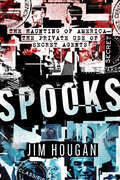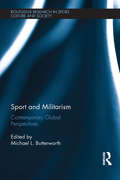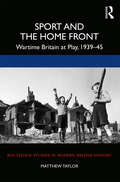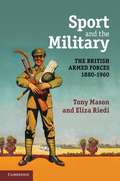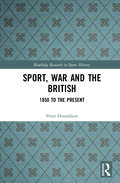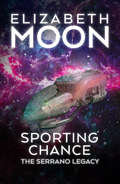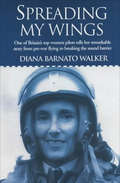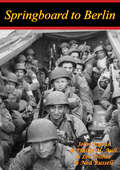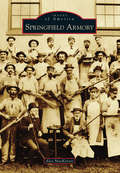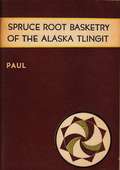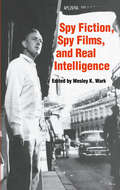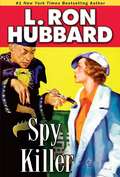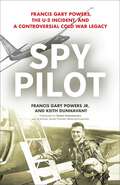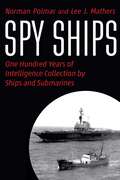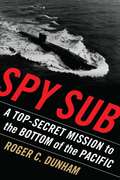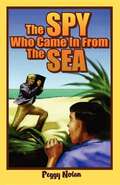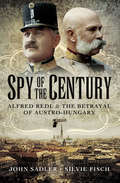- Table View
- List View
Spoils of War: The Fate of Enemy Fleets after the Two World Wars
by Aidan Dodson Serena CantAn extensive history of enemy fleets following both World Wars, featuring never-before-seen archival and archaeological materials.Spoils of War traces the histories of navies and ships of the defeated powers from the months leading up to the relevant armistices or surrenders to the final execution of the appropriate post-war settlements. In doing so, it discusses the way in which the victorious powers reached their final demands, how these were implemented, and to what effect. The later histories of ships that saw subsequent service, either in their original navies or in those navies which acquired them, are also described. Much use is made of archival materials, and in some cases archaeological, sources, some of which have never previously been used. Ultimately, a wide range of long-standing myths are busted, and some badly distorted modern views are set right.The fascinating narrative is accompanied by lists of all major navy-built (and certain significant ex-mercantile) enemy ships in commission at the relevant date of the armistice or surrender, or whose hulks were specifically listed for attention in post-Second World War allied agreements. These include key dates in their careers and their ultimate fates.This original book, featuring numerous photographs, is sure to become an essential reference tool for all those interested in the naval history of the two World Wars.Praise for Spoils of War“Most highly recommended.” —Firetrench“For those who need to finally know the ultimate fate of the often gallant ships that strove against the Allies in both world wars, this is the book.” —Julian Stockwin, author of the Thomas Kydd series
Spokane Hot Rodding (Images of America)
by John GunsaulisSpokane, located just 20 miles from the Idaho border, is the largest city in Eastern Washington, and during the 1940s, it became a center point of an evolving postwar hot rod community. Auto sports were expanding at this time from stock car and midget racing to street cars and drag racing. Local car enthusiasts joined together with an influx of military personnel and college students who were just as passionate for hot rodding, and it was during this time that the Spokane hot rodding culture started flourishing. Together, they pushed the boundaries of hot rodding and created lifelong bonds in the process. This book explores that evolution of inland northwest hot rodding from the mid-1940s to the mid-1960s, starting with the jalopy-styled hot rods that began popping up on local streets to the formation of new clubs and organized racing.
Spokane Story: A Colorful Early History of the Capital of the Inland Empire
by Lucile Foster FosterAt the falls of the Spokane River, in the heart of Washington’s now booming Inland Empire, Spokane stands as a symbol of an America that, in many ways, is only just beginning, and Miss Fargo here gives the story of its rise from trading post to regional metropolis.Lightly and skillfully she brings the city and its past to life through the toil, the triumphs, the zest for work and fun of its citizens—people like: Ross Cox, “scribbling clerk” of the fur trade era who was lost for two terrifying weeks in the Palouse hills; Father Cataldo of the Jesuits from whose “rock pile” arose Gonzaga University; the hotel-keeper’s wife whose party dress froze to the wall just as she was about to show Spokane its first waltz; Jim Glover, “Father of Spokane;” and “Dutch Jake,” who ran a gambling resort and crossed swords with Ida Tarbell.Spokane Story is the colorful history of a colorful city and its people, from the years of its lusty youth to the day when a clergyman sat in the Mayor’s chair and a new city charter heralded the end of its days as a frontier town.
Spooks: The Haunting of America—The Private Use of Secret Agents
by Jim Hougan&“Probably the most eye-opening and engrossing exposé to date of the bizarre &‘power games&’ played by multinational corporations and tycoons.&” —Publishers Weekly A classic of investigative reporting, Spooks is a treasure trove of who-shot-who research on the metastasis of the US intelligence community, whose practices and personnel have engulfed the larger society. Teeming with tales of wiremen, hitmen, and mobsters; crooked politicians and corrupt cops going about their business of regime-change, union-busting, wiretapping, money laundering, and industrial espionage, read about: • Richard Nixon&’s &“Mission Impossible&” war on Aristotle Onassis • Not-so-deep-fake porno films starring the CIA&’s enemies • The Robert Vesco heist, targeting billions in numbered Swiss accounts • Robert Maheu and the kidnapping of billionaire Howard Hughes • The murder-for-hire of a Columbia University professor • Bobby Kennedy&’s archipelago of private intelligence agencies—Intertel and the &“Five I&’s&” • &“The Friendly Ghost&” and Nixon&’s secret account in the offshore Castle Bank & Trust &“One of the best non-fiction books of the year, a monument of fourth-level research and fact-searching.&” —Los Angeles Times&“This book will curl your hair with its revelations and the names it names. A landmark book in its field of investigative reporting.&” —John Barkham Reviews &“Hougan is a superb storyteller and the pages teem with unforgettable characters. Admirable.&” —The Washington Post &“Hougan is exhilarating on the mystique of spooks.&” —The New York Review of Book
Sport and Militarism: Contemporary global perspectives (Routledge Research in Sport, Culture and Society)
by Michael L. ButterworthThe institutional relationship between sport and the military appears to be intensifying. In the US for example, which faced global criticism for its foreign policy during the "war on terror," militaristic images are commonplace at sporting events. The growing global phenomenon of conflating sport with war calls for closer analysis. This critical, interdisciplinary and international book seeks to identify intersections of sport and militarism as a means to interrogate, interrupt and intervene on behalf of democratic, peaceful politics. Viewing sport as a crucial site in which militarism is made visible and legitimate, the book explores the connections between sport, the military and the state, and their consequent impact on wider culture. Featuring case studies on sports such as association football, baseball and athletics from countries including the US, UK, Germany, Canada, South Africa, Brazil and Japan, each chapter sheds new light on the shifting significance of sport in our society. This book is fascinating reading for all those interested in sport and politics, the sociology of sport, communication studies, the ethics and philosophy of sport, or military sociology.
Sport and the Home Front: Wartime Britain at Play, 1939-45 (Routledge Studies in Modern British History)
by Matthew TaylorSport and the Home Front contributes in significant and original ways to our understanding of the social and cultural history of the Second World War. It explores the complex and contested treatment of sport in government policy, media representations and the everyday lives of wartime citizens. Acknowledged as a core component of British culture, sport was also frequently criticised, marginalised and downplayed, existing in a constant state of tension between notions of normality and exceptionality, routine and disruption, the everyday and the extraordinary. The author argues that sport played an important, yet hitherto neglected, role in maintaining the morale of the British people and providing a reassuring sense of familiarity at a time of mass anxiety and threat. Through the conflict, sport became increasingly regarded as characteristic of Britishness; a symbol of the ‘ordinary’ everyday lives in defence of which the war was being fought. Utilised to support the welfare of war workers, the entertainment of service personnel at home and abroad and the character formation of schoolchildren and young citizens, sport permeated wartime culture, contributing to new ways in which the British imagined the past, present and future. Using a wide range of personal and public records – from diary writing and club minute books to government archives – this book breaks new ground in both the history of the British home front and the history of sport.
Sport and the Military: The British Armed Forces, 1880-1960
by Tony Mason Eliza RiediOn battleships, behind the trenches of the Western Front and in the midst of the Desert War, British servicemen and women have played sport in the least promising circumstances. When 400 soldiers were asked in Burma in 1946 what they liked about the Army, 108 put sport in first place - well ahead of comradeship and leave - and this book explores the fascinating history of organised sport in the life of officers and other ranks of all three British services from 1880-1960. Drawing on a wide range of sources, this book examines how organised sport developed in the Victorian army and navy, became the focus of criticism for Edwardian army reformers, and was officially adopted during the Great War to boost morale and esprit de corps. It shows how service sport adapted to the influx of professional sportsmen, especially footballers, during the Second World War and the National Service years.
Sport, War and the British: 1850 to the Present (Routledge Research in Sports History)
by Peter DonaldsonSpanning the colonial campaigns of the Victorian age to the War on Terror after 9/11, this study explores the role sport was perceived to have played in the lives and work of military personnel, and examines how sporting language and imagery were deployed to shape and reconfigure civilian society’s understanding of conflict. From 1850 onwards war reportage – complemented and reinforced by a glut of campaign histories, memoirs, novels and films – helped create an imagined community in which sporting attributes and qualities were employed to give meaning and order to the chaos and misery of warfare. This work explores the evolution of the Victorian notion that playing-field and battlefield were connected and then moves on to investigate the challenges this belief faced in the twentieth century, as combat became, initially, industrialised in the age of total warfare and, subsequently, professionalised in the post-nuclear world. Such a longitudinal study allows, for the first time, new light to be shed on the continuities and shifts in the way the ‘reality’ of war was captured in the British popular imagination. Drawing together the disparate fields of sport and warfare, this book serves as a vital point of reference for anyone with an interest in the cultural, social or military history of modern Britain.
Sporting Chance: Sporting Chance (Serrano Legacy #2)
by Elizabeth MoonDanger threatens the stability of the galaxy in this intriguing second novel in The Serrano Legacy—from Hugo Award-winning and New York Times bestselling author Elizabeth Moon.After narrowly escaping from a twisted cabal that organized hunting parties using human prey, ex-Regular Space Service officer Heris Serrano and her wealthy employer Lady Cecelia must transport a special passenger home.He is Prince Gerel—first in line to the throne. Unfortunately, he was also a somewhat unknowing participant in the “hunt,” and his family is quite eager to avoid a scandal. But Lady Cecelia notices that Gerel is not himself. In fact, he seems mentally impaired, as if he’s been drugged, but the prince’s possible poisoning is only the beginning.When Heris and Cecelia arrive at the royal stronghold of Rockhouse Major, they are pulled into a political conspiracy rooted in pettiness and desires for revenge. As outside agents make moves to unseat the throne, Cecelia is incapacitated by a bitter enemy from her past.Without the protection of her benefactor, Heris and her skeleton crew must navigate the perilous halls of power to rescue Cecelia, the prince, and possibly the universe…
Sporting Firearms of Today in Use: A Look Back at the Guns and Attitudes of the 1920s?and Why They Still Matter
by Paul A. Curtis Jr.The world of sporting firearms is a constantly changing one, but it’s always important to remember the past of the sport. Sporting Firearms of Today in Use is a vintage text written by the shooting editor of Field and Stream during that time. Full of incredible insights, Sporting Firearms of Today in Use covers such topics as: * Choosing a rifle * The killing power of the shotgun * English vs. American shooting * The use of a compass * Bird dogs and hounds * Field etiquette * And much more! Now almost a hundred years after its first publication, Sporting Firearms of Today in Use remains a valuable source of information on sporting firearms from the 1920’s.
Spreading My Wings: One of Britain's Top Women Pilots Tells Her Remarkable Story from Pre-War Flying to Breaking the Sound Barrier
by Diana Barnato WalkerThe remarkable autobiography of a pioneering female aviator who left a privileged life to serve in World War II. Her father was a millionaire race-car driver who became chairman of Bentley Motors, and her grandfather cofounded the De Beers mining company. But by the late 1930s, debutante Diana Barnato had enough of her affluent, chaperoned existence and sought excitement in flying—soloing at Brooklands after only six hours&’ training. Joining the Air Transport Auxiliary in 1941 to help ferry aircraft to squadrons and bases throughout the country, she flew scores of different aircraft—fighters, bombers, and trainers—in all kinds of conditions, and without a radio. By 1945, Barnato had lost many friends, a fiancé, and a husband—but she continued to fly. In 1962 she was awarded the Jean Lennox Bird Trophy for notable achievement in aviation, but her greatest moment was yet to come, when in 1963 she flew a Lightning through the sound barrier, becoming &“the fastest woman in the world.&” Spreading My Wings is her remarkable memoir, brimming with history and adventure.
Spring Comes to Emmerdale: an uplifting story of love and hope (Emmerdale, Book 2) (Emmerdale)
by Pamela BellTHE PERFECT GIFT FOR MOTHER'S DAYSpring Comes to Emmerdale is a must for fans of ITV's Emmerdale, and readers who love heartwarming and heartbreaking stories set during wartime, alike.'Enthralling. Spring Comes to Emmerdale is beautifully written and researched' - Lancashire Evening PostWorld War I wages on, and the families of Emmerdale are trying their best to move on from tragedy, while the effects of war still resonate throughout the village of Beckindale. Though grief and loss permeate, Maggie Sugden, Rose Haywood and the other inhabitants of the village are finding independence, the chance to make their own happiness - and even opening themselves up to find love. Featuring firm fan favourites like the Dingles, The Woolpack Pub and Emmerdale Farm itself, this will be a delight for any Emmerdale fan.Following on from the first in the series, Christmas At Emmerdale, the second novel picks up where the first left-off, exploring the lives of Emmerdale's much-loved families during the Great War and beyond, and how the nation's favourite village copes with the loves and lives lost.
Spring Will Come (The Bregdan Chronicles #3)
by Ginny DyeVolume 3 of the Bregdan Chronicles, Spring Will Come, continues the sweeping historical saga that now encompasses the second year of the American Civil War. As her beloved city of Richmond is transformed into a deadly Civil War battlefield, spirited Carrie Cromwell puts her medical skills to use in a Confederate hospital. Yet she struggles to understand the prejudice of her fellow Southerners. Does she really want the South to win? And will the war cost her the man she loves? Meanwhile, in the North, Rose and Moses have found freedom at last--only to be separated by war. Can Moses, now a Union spy, elude those searching for him as a runaway slave? Rose, inspired by a courageous woman, returns to Virginia to teach in a contraband camp.
Springboard To Berlin
by Phillip H. Ault John ParrisEarly on the morning of November 8th, 1942, Allied invasion forces struck simultaneously at half a dozen places in North Africa. From that moment news of the campaign poured out from innumerable points up and down the coast.Obviously no one person could be everywhere at once, or could hope to tell the complete story. This could only be done by the collaboration of several of those who were there.Springboard to Berlin is the work of four correspondents of the United Press.John A. Parris, Jr. in the London office was in an excellent position to give us a glimpse of what went on before those convoys finally slipped through the Straits of Gibraltar (Part I). He also covers Oran (Part V), having gone in with the troops at Arzu. His familiarity with the whole picture has enabled him to also provide a portion on Casablanca (Part IV) and later a chapter on the Casablanca Conference (Part VII).Leo Disher had the unique experience of actually sailing on H.M.S. Walney, which was sent to break the boom at Oran harbor (Part II).Ned Russell covers Operations at Algiers (Part III), and the November-December dash for Bizerte and Tunis (Part VI). Attached to the British First Army, he went up the coast from Bône. He also witnessed the final knockout at Bizerte and Tunis (Part IX, sent to London). John Parris and Phil Ault, then in London, also contributed to the section and got it into the hands of a naval officer bound for New York. Finally, Ned Russell continued across the Mediterranean with the invasion forces (Part X), analyzing the breakdown of the Axis African army and describing the conquest of Lampedusa and most of Sicily.Phil Ault was in the thick of the fighting at Kasserine Pass, El Guettar in Tunisia, and the other famous battles. In Part VIII he tells how the Americans won their spurs there.
Springfield Armory (Images of America)
by Alex MackenziePres. George Washington authorized Springfield Armory to begin manufacturing small arms for the US military in 1794. Over nearly two centuries until its closure in 1968, the government armory at Springfield, Massachusetts, became legendary, not only for the arms provided to soldiers during conflicts such as the War of 1812, the Civil War, and World War II, but also for the way in which those arms were crafted. The drive to produce firearms of high quality and quantity for the nation's military created a need to improve manufacturing methods and machinery. Armory advancements, such as the interchangeability of parts, helped lay the groundwork of the American Industrial Revolution. Because of these efforts, Springfield Armory is recognized not only as a first-rate government arms manufacturer, but also as a hub of industry, attracting thousands of skilled men and women from around the world.
Spruce Root Basketry of the Alaska Tlingit
by Frances Lackey PaulThe beautiful, artistic, and unique baskets of the Tlingit of southeastern Alaska. Numerous photos throughout.From earliest times the basket was made to use. In the huge community house of the winter village or the bark shelter of the summer fishing camp the furniture Consisted of baskets and wooden boxes. The old Tlingit did not understand the arts of pottery making or metal working. Baskets were used for cooking kettles, in which the women placed their meat or berries. They then dropped hot stones on the food with wooden tongs, added enough water to generate steam, covered the basket, and then set it aside until the food was cooked. Baskets, so closely woven as to be water tight, were their water jars and drinking cups. Baskets were one form of the family trunk, especially when traveling, because of their light weight. Baskets were used for gathering berries, roots and shellfish, for trying out seal and eulachon oil, for food dishes and for storage of food for winter. The typical work hat of the district, even some types of ceremonial hat, the headdresses of shaman or Indian doctors, shot pouches, work baskets, rattles and spoon bags were all woven from spruce root or cedar bark. This art was also used to make fish traps, net bags for eulachon fishing, huge mats for canoe sails and floor covering, the cradle swing for the baby and the winding sheet for the old shaman when his body was taken to the lonely burial house.
Spy Fiction, Spy Films and Real Intelligence (Studies in Intelligence)
by Wesley K. WarkThis book won the Canadian Crime Writers' Arthur Ellis Award for the Best Genre Criticism/Reference book of 1991. This collection of essays is an attempt to explore the history of spy fiction and spy films and investigate the significance of the ideas they contain. The volume offers new insights into the development and symbolism of British spy fiction.
Spy Killer
by L. Ron HubbardDiscover intrigue and suspense. Kurt Reid may be innocent of the murder he's charged with (and of grand larceny, for that matter), but he's got no time to be thrown in jail and defend himself. Instead, Reid flees to pre-Communist China and Shanghai, the exotic city of mystery and death.Reid takes refuge in a tea house where he meets White Russian Varinka Savischna, whom he manages to rescue from certain death. As beautiful as she is smart, she recruits him in her crusade against Chinese intelligence services. Unfortunately, Reid manages to get himself captured by the Chinese and blackmailed into pursuing and assassinating a Japanese spy.Now Reid must enter the cloak-and-dagger world of espionage and intrigue, where everything and everyone is not who or what they appear to be. "...novella length adventure-cum-mystery stories based in 1930's China offer further evidence of Hubbard's pulp-action mastery." --Ellery Queen
Spy Pilot: Francis Gary Powers, the U-2 Incident, and a Controversial Cold War Legacy
by Keith Dunnavant Francis Gary Powers Jr.Based on newly available information, the son of famed U-2 pilot Francis Gary Powers presents the facts and dispels misinformation about the Cold War espionage program that turned his father into a Cold War icon..One of the most talked-about events of the Cold War was the downing of the American U-2 spy plane piloted by Francis Gary Powers over the Soviet Union on May 1, 1960. The event was recently depicted in the Steven Spielberg movie Bridge of Spies. Powers was captured by the KGB, subjected to a televised show trial, and imprisoned, all of which created an international incident. Soviet authorities eventually released him in exchange for captured Soviet spy Rudolf Abel. On his return to the United States, Powers was exonerated of any wrongdoing while imprisoned in Russia, yet, due to bad press and the government's unwillingness to heartily defend Powers, a cloud of controversy lingered until his untimely death in 1977. Now his son, Francis Gary Powers Jr. and acclaimed historian Keith Dunnavant have written this new account of Powers's life based on personal files that had never been previously available. Delving into old audio tapes, letters his father wrote and received while imprisoned in the Soviet Union, the transcript of his father's debriefing by the CIA, other recently declassified documents about the U-2 program, and interviews with the spy pilot's contemporaries, Powers and Dunnavant set the record straight. The result is a fascinating piece of Cold War history. This is also a book about a son's journey to understand his father, pursuing justice and a measure of peace.Almost sixty years after the fact, this will be the definitive account of one of the most important events of the Cold War.
Spy Ships: One Hundred Years of Intelligence Collection by Ships and Submarines
by Norman Polmar Lee J. MathersAlmost from the first days of seafaring, men have used ships for &“spying&” and intelligence collection. Since early in the twentieth century, with the technological advancements of radio and radar, the U.S. Navy and other government agencies and many other navies have used increasingly specialized ships and submarines to ferret out the secrets of other nations. The United States and the Soviet Union/Russia have been the leaders in those efforts, especially during the forty-five years of the Cold War. But, as Norman Polmar and Lee J. Mathers reveal, so has China, which has become a major maritime power in the twenty-first century, with special interests in the South China Sea and with increasing hostility toward the United States. Through extensive, meticulous research and through the lens of such notorious spy ship events as the Israeli attack on the USS Liberty, the North Korean capture of the USS Pueblo, and the U.S. Central Intelligence Agency&’s success in clandestinely salvaging part of a Soviet submarine with the Hughes Glomar Explorer, Spy Ships is a fascinating and valuable resource for understanding maritime intelligence collection and what we have learned from it.
Spy Sub
by Roger C. DunhamThis is a story about a secret mission to find a lost Soviet submarine in the great depths of the Pacific Ocean, a mission never acknowledged by the U. S. Department of Defense. Deeply beneath the searching navy of the Soviet Union, the nuclear submarine hunt was so secret that even the men on the vessel never knew the object of their search. The brave exploits of these sailors and their remarkable commanding officer, enduring near-tragedies at sea and nearly-impossible challenges deep under the Pacific, are described by the author who also provides his own personal experiences under the tightest secrecy ever required for a submarine mission. The failures, the near catastrophes, and the challenges are described in personal detail, and the final outcome bringing critical Cold War information to the president of the United States is a saga like none in the annals of submarine exploits.
Spy Who Came in from the Sea (Florida Historical Fiction for Youth)
by Peggy NolanFourteen-year old Frank Hollahan moves to Florida in 1943, at the height of World War II, to join his father, a navy seaman. When Frank and his mother arrive at the busy naval port of Jacksonville, a surprising new life awaits them. In this new place, Frank's life changes in ways he never imagined. In his new school, his tendency toward exaggeration quickly builds him a reputation as a teller of tales. He wanders to the beach one night and sees what seems to be a man coming ashore from a submarine. When he informs his family, friends, and teachers that he saw a spy from a German U-boat land on the local beach, no one believes him. Is the spy real, or is he only a part of Frank's imagination and exaggeration? Frank is certain the spy has plans for sabotage. With the aid of Rosemarie Twekenberry, who has eyes only for Frank, and a mysterious beach recluse known as Weird Wanda, Frank sets out to prove the spy's existence. With time running out, Frank must figure out a way to stop him. Each rumor and discovery—whether a buried chest, a secret code, or a mysterious note—presents new problems. The truth finally comes to light at the big bond rally in the shipyard as Frank's class presents a rousing patriotic program, led by Mr. Jolly, an ex-clown turned teacher. Thrown into the mix are a brash, redheaded student named Howard; Gladys, the organizer; and other zany characters who all join in the tangled web of this wartime mystery, based on an actual occurrence. The spy who came in from the sea ends up teaching Frank—and the people of Jacksonville—valuable lessons about friendship, perseverance, and the power of the truth.Next in series > >See all of the books in this series
Spy and Counterspy: Secret Agents and Double Agents from the Second World War to the Cold War
by Ian DearThe shadowy world of supposedly legalized spying has an enduring fascination for us all. Spy and Counterspy reveals for the first time the web of spies that spanned the globe during and after the Second World War, working for organisations like MI5 & MI6, the CIA & OSS, Soviet Smersh & NKVD, Japanese Tokko and the German Gestapo. These men and women lived extraordinary lives, always on the edge of exposure and the risk of death. Many of them were so in love with the Great Game of espionage that they betrayed their countries and acted as double and sometimes even triple agents in a complex deception that threatened the very grasp of power in government. Their war in the shadows remained unrecognized until today.
Spy of the Century: Alfred Redl & the Betrayal of Austro-Hungary
by John Sadler Silvie FischThis military biography reveals the secret life of a closeted Austro-Hungarian intelligence officer who became a double agent in pre-WWI Europe. On the night of May 24th, 1913, three high-ranking military officials waited outside a hotel in the center of Vienna. At around two am they heard a gunshot and knew that one of their own had just ended his life. Colonel Alfred Redl, the former deputy head of the Evidenzbüro, the Austro-Hungarian General Staff&’s directorate of military intelligence, and confidant of the heir to the throne. His suicide note read: &‘Levity and passion have destroyed me&’. No one knew that for almost a decade, Redl had been giving military secrets to the Italians, French, and Russians. His motives for betraying the army he revered were a mystery for over a century. But after the discovery of long-lost records, the truth has been revealed.Spy of the Century tells the tragic story of a devoted military man who was forced to hide his homosexuality, and used his wealth to please his young lover. Authors John Sadler and Silvie Fisch vividly reconstruct Redl&’s secret life and dramatic downfall.
Spy: A Novel
by Danielle SteelA young woman is caught up in a dangerous double life on behalf of her country during World War II in Danielle Steel&’s thrilling new novel. At eighteen, Alexandra Wickham is presented to King George V and Queen Mary in an exquisite white lace and satin dress her mother has ordered from Paris. With her delicate blond looks, she is a stunning beauty who seems destined for a privileged life. But fate, a world war, and her own quietly rebellious personality lead her down a different path. By 1939, Europe is on fire and England is at war. From her home in idyllic Hampshire, Alex makes her way to London as a volunteer in the First Aid Nursing Yeomanry. But she has skills that draw the attention of another branch of the service. Fluent in French and German, she would make the perfect secret agent. Within a year, Alex is shocking her family in trousers and bright red lipstick. They must never know about the work she does—no one can know, not even the pilot she falls in love with. While her country and those dearest to her pay the terrible price of war, Alex learns the art of espionage, leading to life-and-death missions behind enemy lines and a long career as a spy in exotic places and historic times. Spy follows Alex&’s extraordinary adventures in World War II and afterward in India, Pakistan, Morocco, Hong Kong, Moscow, and Washington, D.C., when her husband, Richard, enters the foreign service and both become witnesses to a rapidly changing world from post-war to Cold War. She lives life on the edge, with a secret she must always keep hidden.
